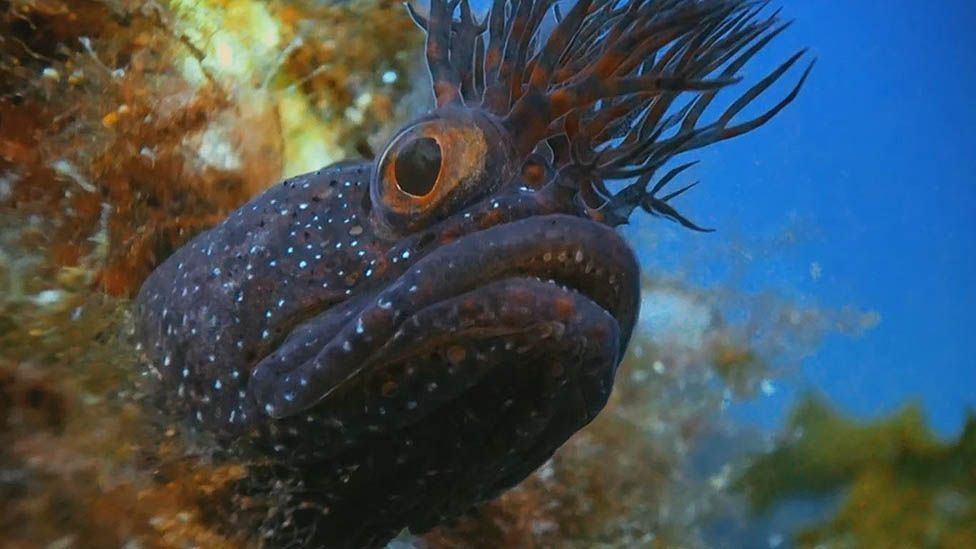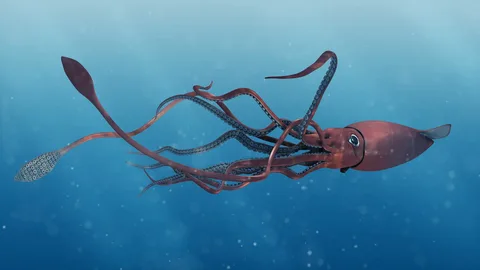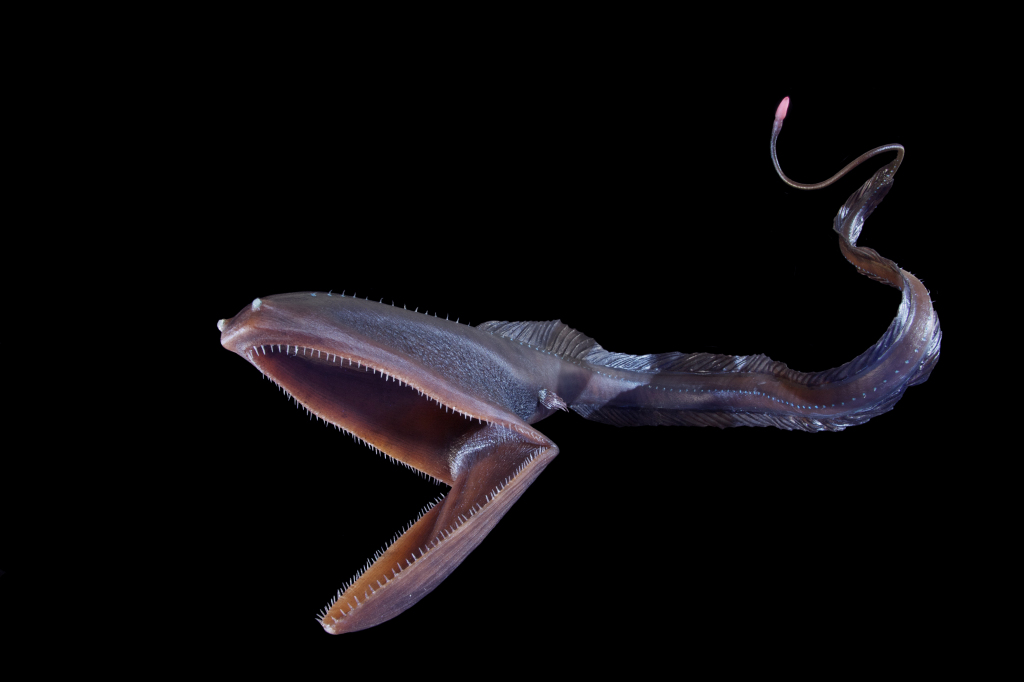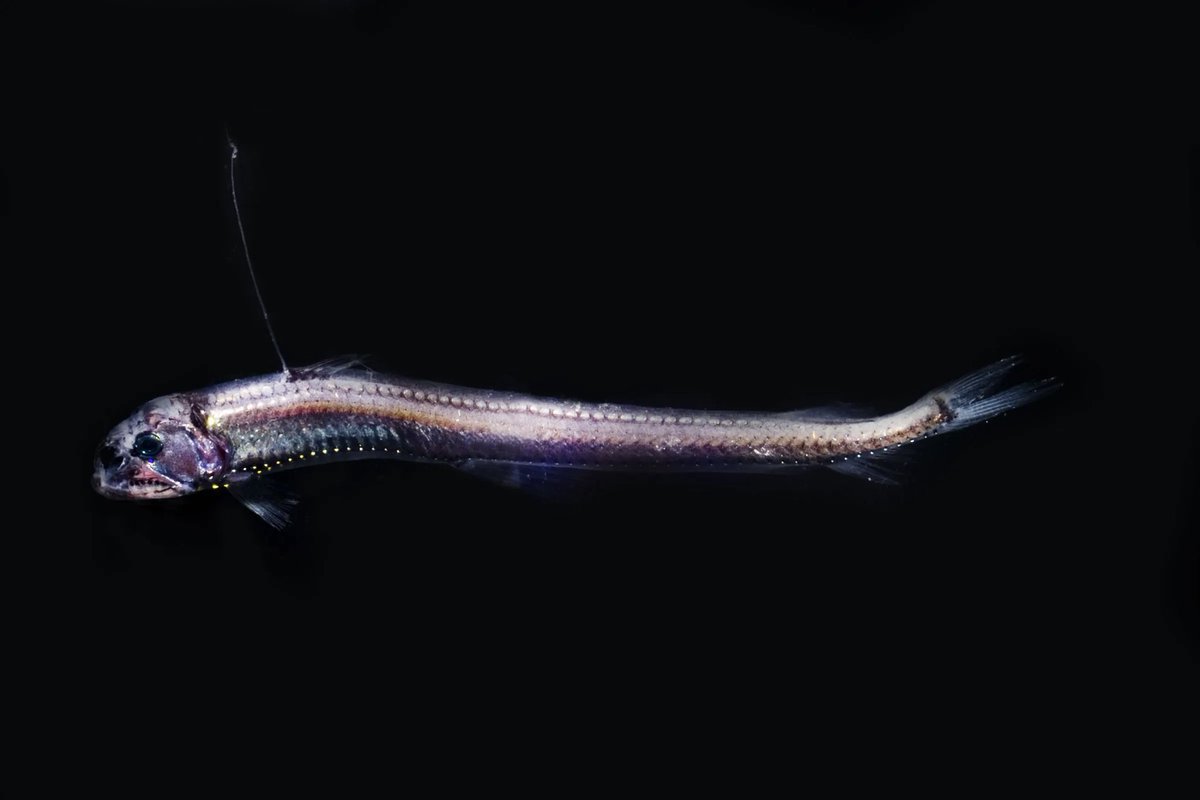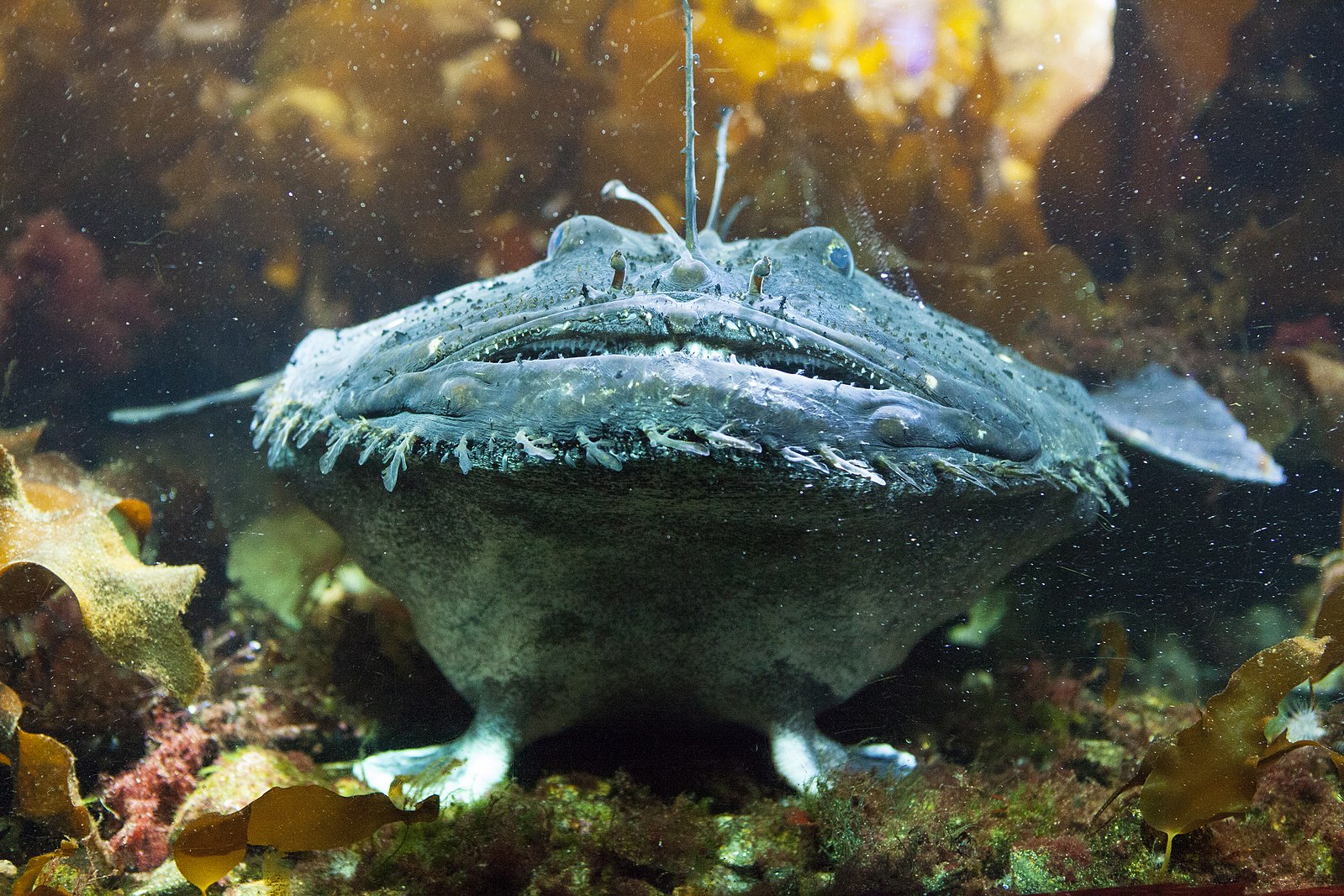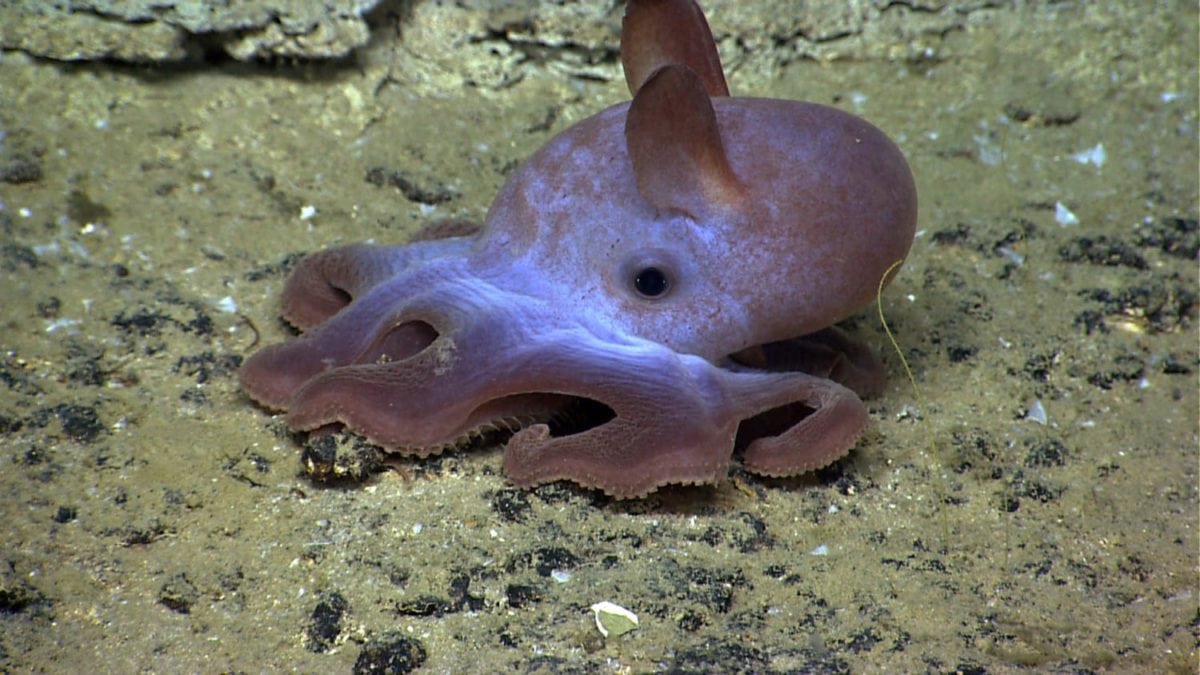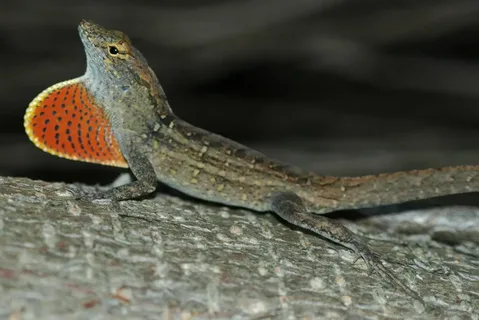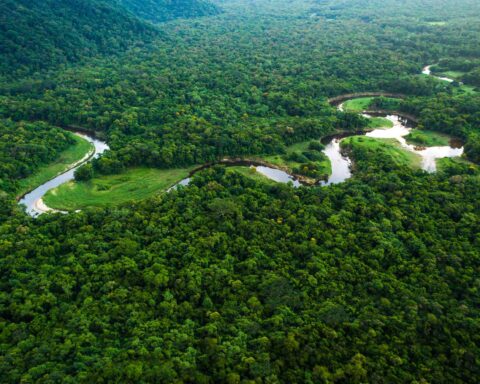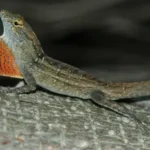Deep-Sea Giants
Giant Squid
The giant squid is a massive animal that inhabits the deep oceans around the world. It is a cephalopod, related to octopuses and cuttlefish, but it is by far the largest species in this group.
Giant squids have been known to reach lengths of up to 13 meters (43 feet) and weigh as much as 750 kilograms (1,650 pounds), making them one of the largest invertebrates on Earth. Their massive bodies are thought to be able to stretch even longer, up to 15 meters or more, but this is difficult to measure accurately.
They have a broad, flattened body, with ten long arms covered in suckers that help them grasp and move through the water. Their bodies are also equipped with large, bulbous eyes that are thought to be capable of perceiving light in very low levels of illumination.
Giant squids live deep in the ocean, typically at depths between 200 and 700 meters (660 to 2,300 feet). They have been found as far down as 1,000 meters, although this is less common. They prefer areas with a high concentration of food, such as around underwater mountains or where cold water meets warmer currents.
The giant squid’s diet consists mainly of deep-sea fish and other invertebrates like crustaceans and other cephalopods. They have a large, sharp beak that helps them break open the shells of their prey, and their suckers are lined with tiny teeth that help them grasp onto and eat their food.
Despite their size and strength, giant squids are still a relatively poorly understood animal, due in part to their deep-water habitat. Only a few specimens have been brought to the surface alive, making it difficult for scientists to study them in detail. However, through the use of submersibles and remotely operated vehicles (ROVs), scientists have been able to observe giant squids in their natural habitat and learn more about their behavior and physiology.
Giant squids are considered a key species by some scientists, meaning that they play an important role in maintaining the balance of the marine ecosystem. However, they are also considered an important food source for other animals like sperm whales, which feed on giant squid and its relatives.
Found in oceans around the world, giant squid have massive eyes and beaks.
The deep ocean is home to an array of fascinating creatures that continue to capture the imagination of scientists and the general public alike. Among these, the giant squid stands out as one of the most intriguing and enigmatic animals found in oceans around the world.
Giant squid (Architeuthis dux) are massive cephalopods that have been inhabiting the deep waters of our planet for millions of years. They possess a range of remarkable physical characteristics that enable them to thrive in this harsh, dark environment. One of their most striking features is their eyes, which can reach up to 10 inches (25 cm) in diameter – making them the largest eyes of any animal on record.
The size of these enormous eyes allows giant squid to detect the faint glow of bioluminescent organisms and to perceive the limited sunlight that filters down from above. This exceptional vision is crucial for their survival, as it helps them locate prey and navigate through the darkness.
Giant squid also have powerful beaks, which they use to capture their food – primarily deep-sea fish and other squid. The beak is a hardened, tooth-like structure that is capable of exerting an incredibly strong grip on its victims. It’s thought that this remarkable beak plays a vital role in the giant squid’s feeding behavior.
Despite being found in oceans around the world, from the Arctic to the Antarctic and every ocean in between, giant squid are notoriously difficult to study. They inhabit extreme environments with near-freezing temperatures and immense pressure – conditions that make it challenging for humans to explore their habitats.
However, through advances in technology and the development of submersible vehicles, scientists have been able to catch glimpses into the world of these magnificent creatures. These expeditions have revealed new insights into the biology and behavior of giant squid, shedding light on one of the most fascinating and elusive animals of the deep ocean.
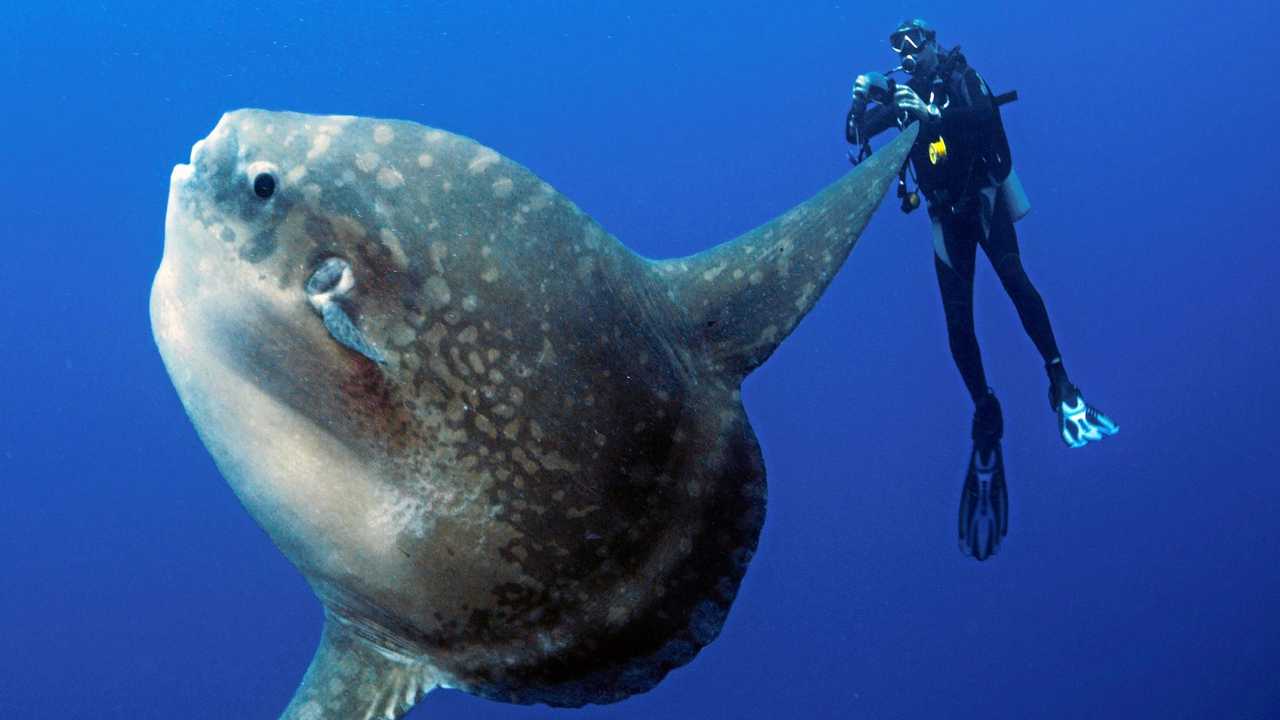
Sunfish
- Sunfish are one of the most fascinating animals that live in the deep ocean, and they have adapted to life in this environment in unique ways.
- The sunfish is a large fish that can grow up to 14 feet in length and weigh over 5,000 pounds, making it one of the largest bony fish in the world.
- They are characterized by their rounded body shape, long pectoral fins, and distinctive vertical tail fin.
- Sunfish have a unique way of moving through the water, using their large dorsal fin to propel themselves forward.
Some interesting facts about sunfish:
No swimming bladder: Unlike other fish, sunfish do not have a swim bladder, which is an organ that helps them maintain buoyancy in the water.
Can be found in both warm and cold waters: Sunfish can be found in tropical, subtropical, and temperate waters around the world, from the Caribbean to Japan.
Diet consists mainly of jellyfish: Sunfish are filter feeders and their diet consists mainly of jellyfish, as well as other soft-bodied organisms such as salps and sea squirts.
Physical adaptations
Large size: Sunfish have evolved to grow very large in order to be able to eat the abundant jellyfish in the ocean.
Flat head: Sunfish have a flat, rounded head that is perfectly suited for feeding on jellyfish.
Dorsal fin: The dorsal fin of the sunfish is large and triangular in shape, allowing it to propel itself through the water with ease.
Behavior and habitat
Sunfish are generally found in open ocean waters, often far from land.
They tend to stay at depths of around 200-400 meters (660-1,310 feet), but have been known to dive as deep as 700 meters (2,300 feet).
Sunfish are slow-moving animals that do not migrate or school.
Reaching up to 14 feet in length, sunfish are one of the largest bony fish in the ocean.
Sunfish, also known as Mola mola, are truly fascinating creatures that inhabit the world’s oceans. Reaching up to 14 feet in length and weighing a massive 5,000 pounds or more, they are indeed one of the largest bony fish in the ocean.
Found in temperate and tropical waters around the globe, sunfish are often seen near the surface of the water, where they feed on small fish, jellyfish, and even plankton. They have a distinctive round body shape, with a flattened head and a long, pointed snout.
Despite their enormous size, sunfish are incredibly slow swimmers, with some studies suggesting that they can move at a pace of just 0.77 miles per hour. This slow movement is thought to be an adaptation for conserving energy in the nutrient-poor waters where they live.
Sunfish have a number of unique physical adaptations that allow them to thrive in their deep ocean environment. Their body shape allows them to maintain a relatively stable buoyancy, even in areas with low water density, while their skin is covered in tiny scales and mucous glands that help to protect them from predators.
One of the most remarkable features of sunfish is their incredible ability to dive to great depths in search of food. They have been tracked using satellite tracking devices, which have revealed that they can reach depths of up to 6,500 feet or more in a single dive. This is an impressive feat for any fish, and highlights the impressive adaptability of these remarkable creatures.
Unfortunately, sunfish are facing numerous threats in their natural habitat, including overfishing, bycatch, and habitat degradation. As a result, many populations are experiencing decline or even extinction. Conservation efforts are underway to protect these incredible animals, but more research is needed to understand the full extent of the threats they face.
Despite the challenges facing sunfish in the deep ocean, scientists continue to learn more about these fascinating creatures through ongoing research and conservation initiatives. By studying their behavior, physiology, and ecology, we can gain a deeper understanding of how to protect them and preserve their place in our oceans for generations to come.
Deep-Sea Communities
Gulper Eels
The deep ocean is home to an array of fascinating creatures, with the Gulper Eel being one of its most unique inhabitants. Found in tropical and temperate waters around the world, this peculiar animal has adapted to survive in some of the harshest conditions on the planet.
The Gulper Eel, also known as the Eurypharynx pelecanoides, is a member of the family Eurypharyngidae. It’s characterized by its massive mouth, which can open wide enough to swallow prey whole – even if it’s larger than itself. This impressive gape is made possible by a highly flexible jaw and a set of incredibly powerful muscles.
The Gulper Eel has a slender body, typically ranging from 20 to 30 centimeters in length. It features a long, thread-like tail and large eyes that are said to be among the largest in relation to its body size of any animal on the planet. This remarkable visual system is likely an adaptation for navigating through the dark, food-scarce environment of the deep ocean.
The Gulper Eel inhabits depths ranging from 100 to 7,000 meters, making it one of the few fish species that can be found in both mesopelagic and bathypelagic zones. It uses its bioluminescent lures – which are thought to be highly sensitive to light – to communicate with other Gulper Eels or attract prey in the dark depths.
The diet of the Gulper Eel consists mainly of squid, shrimp, and small fish. It also has been known to consume marine worms and crustaceans on occasion. Given its ability to swallow large prey whole, it’s not uncommon for Gulper Eels to be found with partially digested food items in their stomachs.
The Gulper Eel’s unique appearance and fascinating behaviors have captivated the imaginations of scientists and ocean enthusiasts alike. As we continue to explore and learn about these incredible animals, we’re reminded of the awe-inspiring diversity that exists within our planet’s oceans – and the many secrets still waiting to be uncovered.
Found in deep waters, gulper eels have massive mouths that allow them to consume large prey.
The deep ocean is home to a diverse array of creatures, many of which are unlike anything found in shallower waters. One such example can be found in the form of the gulper eel, a fish with an incredibly large mouth that allows it to consume prey much larger than itself.
Found in the deep waters of the Atlantic and Pacific oceans, gulper eels have adapted to a unique environment where light is scarce and food is hard to come by. Their massive mouths are one of their most striking features, allowing them to swallow prey whole that would be too large for other fish to consume.
The mouth of a gulper eel can open wide enough to engulf prey up to twice the size of its own head, making it one of the most efficient predators in the deep ocean. This is due to the eel’s ability to stretch and expand its jaws, allowing it to take in large quantities of food at once.
The gulper eel’s unique feeding strategy allows it to thrive in an environment where other predators would struggle to survive. Its massive mouth also helps to protect it from predators, as few other fish can compete with the eel’s ability to consume and swallow its prey whole.
In addition to their impressive mouths, gulper eels have a range of adaptations that allow them to thrive in the deep ocean. Their large teeth are designed for grasping and holding onto prey, while their long, thin bodies allow them to navigate through narrow crevices and caverns in search of food.
Gulper eels are also able to produce light, a process known as bioluminescence, which helps to attract prey and communicate with other members of the same species. This unique ability is just one of many fascinating features that make the gulper eel such an intriguing creature.
Some key facts about gulper eels include:
- The largest gulper eel recorded was found to be over 3 feet (90 cm) in length and weighed over 20 pounds (9 kg).
- Gulper eels are able to survive at depths of up to 6,000 meters (19,685 ft), making them one of the deepest-living fish in the ocean.
- The gulper eel’s massive mouth is lined with hundreds of tiny teeth that help to grasp and hold onto prey.
- Gulper eels are thought to feed on a range of deep-sea organisms, including squid, shrimp, and other fish.
Viperfish
The deep ocean is home to a vast array of fascinating creatures that are capable of surviving in one of the most inhospitable environments on the planet. Among these creatures, the viperfish is a standout example of an animal that has adapted to life in the dark depths.
The viperfish (Chauliodus sloani) is a species of deep-sea fish that belongs to the family Stomiidae. These fish are found in oceans all around the world, typically at depths ranging from 200-1,300 meters below sea level.
The viperfish has a number of unique features that enable it to thrive in the deep ocean environment. One of its most distinctive characteristics is the presence of large teeth and powerful jaws that allow it to feed on prey much larger than itself.
The viperfish also has a number of bioluminescent lures on its lower jaw, which are thought to be used as a form of decoy to attract prey towards its mouth. These lures can be quite large and may emit a blue-green light that is visible from some distance away.
In addition to their impressive dental equipment and bioluminescent lures, viperfish also have large eyes that are sensitive to dim light. This allows them to detect the faint glow of other organisms in the darkness, which they can then use as a source of food or even a mate.
Despite its fearsome reputation, the viperfish is actually a relatively small fish, typically growing to no more than 30 centimeters in length. It has a slender body and a pointed snout, with a long, thin dorsal fin that runs along its back.
Viperfish are generally solitary animals and only come together during mating season. They are thought to be one of the deepest-living species of fish on the planet, with some specimens having been found at depths as great as 3,000 meters below sea level.
The viperfish is just one example of the many fascinating creatures that live in the deep ocean. These animals have evolved over millions of years to survive in an environment that is characterized by near-total darkness, crushing pressure, and icy-cold temperatures.
Using bioluminescent lures on their lower jaws to attract prey, viperfish are found in the mesopelagic zone.
The deep ocean is a vast, unexplored environment that supports a wide range of unique and fascinating species. Among these, the viperfish stand out for their distinctive appearance and remarkable adaptations to life in the mesopelagic zone.
Also known as bigeye or giant viperfish, Lampadena speculigera is a type of deep-sea fish that has evolved some incredible features to survive in this extreme environment. One of their most notable characteristics is the use of bioluminescent lures on their lower jaws to attract prey.
The mesopelagic zone, also known as the twilight zone, extends from about 200 meters to 1,000 meters below the ocean’s surface. This region receives some sunlight, but it is still a relatively dark environment compared to the surface waters. The viperfish have adapted to this dimly lit world by developing bioluminescent organs that produce light.
The light produced by these organs serves several purposes. It can be used for communication, such as attracting a mate or warning off potential rivals, as well as for luring prey. The bioluminescent lure on the lower jaw of the viperfish is particularly effective at attracting small fish and other invertebrates.
The use of bioluminescent lures on their lower jaws allows viperfish to hunt effectively in the dimly lit waters of the mesopelagic zone. This adaptation has enabled them to thrive in an environment where food may be scarce, and predators are abundant.
In addition to their remarkable bioluminescence, viperfish have other distinctive features that set them apart from other deep-sea fish. They have large teeth, a massive mouth, and a long lower jaw that is lined with rows of sharp teeth. These formidable dental features allow them to grasp and devour prey whole.
The combination of their bioluminescent lures, powerful jaws, and adaptations to the mesopelagic environment make viperfish one of the most fascinating and formidable predators in the deep ocean.
Bullet points summarizing some key facts about viperfish include:
- Bioluminescence: Viperfish have bioluminescent organs that produce light to communicate, lure prey, or confuse predators.
- Habitat: They live in the mesopelagic zone, a region extending from 200 meters to 1,000 meters below the ocean’s surface.
- Diet: Viperfish feed on small fish and other invertebrates that are attracted by their bioluminescent lures.
- Adaptations: Their large teeth, powerful jaws, and distinctive lower jaw make them well-suited to life in the deep ocean.
- Size: Viperfish can grow up to 30 centimeters (12 inches) in length and weigh up to several kilograms.
Overall, viperfish are remarkable creatures that have adapted to the extreme conditions of the mesopelagic zone. Their use of bioluminescent lures on their lower jaws is just one of many fascinating features that make them stand out as a unique and interesting species in the deep ocean.
Unique Adaptations
Anglerfish
The Anglerfish is a fascinating group of deep-sea animals that inhabit the dark, cold waters of the ocean. These unusual creatures belong to the Lophiidae family and are found in oceans around the world.
One of the most distinctive features of Anglerfish is their ability to produce light from their bodies, a process called bioluminescence. This unique characteristic helps them to communicate with other members of their species, as well as lure prey in the dark waters of the deep ocean.
The Anglerfish uses a fleshy growth on its head, known as an illicium, to attract prey and defend itself from predators. This growth is often adorned with bioluminescent bacteria that produce a blue or green glow, making it an effective lure in the dark depths of the ocean.
Anglerfish are also characterized by their unique mating habits. In most species, the female Anglerfish has a modified organ called a genitalia that is used to fertilize the male’s eggs after he has attached himself to her body using his teeth. This process, known as parasitic spawnings, is a remarkable example of the adaptations that have evolved in these deep-sea creatures.
The female Anglerfish is typically much larger than the male and has a longer life expectancy. Males are often found with tiny lures on their bodies, which they use to attract females and eventually attach themselves to her body.
Anglerfish have also been observed to live in pairs or small groups, rather than alone. This social behavior is unusual for deep-sea creatures and highlights the complexity of these fascinating animals.
In terms of their diet, Anglerfish are primarily carnivores, feeding on a variety of prey including fish, crustaceans, and other deep-sea organisms. They use their bioluminescence to lure in prey and then capture it with their powerful jaws and teeth.
Overall, the Anglerfish is an incredible example of the diversity and adaptability of life on our planet. These remarkable creatures have evolved unique features that allow them to thrive in one of the most inhospitable environments on Earth – the deep ocean.
Females of the anglerfish species have a fleshy growth on their head that is used as a lure to attract prey.
The Females of the anglerfish species have evolved a unique and fascinating adaptation that plays a crucial role in their survival. On top of their head, they possess a fleshy growth known as an illicium, which doubles as a lure to attract prey.
This remarkable structure is highly modified from the normal cranial bones found in most fish species and serves several purposes. Firstly, it allows the anglerfish to entice small prey animals towards their mouth by mimicking the appearance of bait or other food sources. This is often accompanied by a wiggling motion that adds further allure to the lure.
The illicium itself can take various forms depending on the species within the anglerfish group, such as being flat and ribbon-like, or having an almost spherical appearance. Some species are even known to sport a small bioluminescent light at the tip of their lure, making it all the more enticing for potential prey.
This unique adaptation is essential for the survival of anglerfish in the deep ocean environments they inhabit. Predominantly living on or near the seafloor, these fish have evolved to thrive under conditions that would be hostile to many other marine animals. The lure serves as a vital tool for capturing food, enabling them to sustain life despite the harsh and competitive environment.
Interestingly, some species of anglerfish are also known to engage in bioluminescence themselves, creating complex communication patterns through the production and manipulation of light. However, their use of bioluminescent signals is largely unrelated to the primary function of their lure and serves distinct purposes.
The intricate biology surrounding the anglerfish’s unique head growth has fascinated marine biologists and scientists alike. Further research into this enigmatic anglerfish adaptation continues to expand our understanding of deep-sea ecosystems, highlighting the incredible diversity and resilience that characterizes life in these environments.
Dumbo Octopus
The deep ocean is home to a vast array of fascinating creatures that continue to captivate the imagination of scientists and marine enthusiasts alike. Among these intriguing animals is the Dumbo octopus, named after the iconic Disney character due to its distinctive ear-like fins that resemble those of the beloved elephant.
Dumbo octopuses belong to the genus Gymnoscaphandriidae and are characterized by their small size, typically reaching lengths of around 20-25 cm (8-10 in). They possess a bulbous head and a soft, boneless body covered with tiny suckers that help them move through the water.
These deep-sea creatures inhabit areas with low oxygen levels and intense pressure, found mostly in areas near Antarctica and the Gulf of Mexico. Their ability to survive in such conditions is likely due to their slow metabolism and ability to conserve energy.
Dumbo octopuses feed on small crustaceans and other tiny organisms that they encounter while swimming through the dark waters. Their large eyes are highly sensitive, allowing them to detect even the faint glow of bioluminescent organisms in the darkness.
The unique ear-like fins of Dumbo octopuses allow them to detect vibrations in the water, helping them navigate and locate potential prey. These fins are also highly flexible and can be used for communication purposes, such as attracting a mate or warning off predators.
Despite their relatively small size, Dumbo octopuses have adapted to life in the deep ocean with remarkable efficiency. Their ability to survive and thrive in conditions that would be hostile to most other animals is a testament to the incredible diversity of life on our planet.
In order to continue studying these fascinating creatures, scientists have developed specialized submersibles and remote-operated vehicles (ROVs) to explore the depths of the ocean and capture footage of Dumbo octopuses in their natural habitat. This ongoing research aims to uncover more about these incredible animals and the ecosystems they inhabit.
Found in deep waters, Dumbo octopuses use large earlike fins to swim and maneuver.
The deep ocean is home to a diverse array of marine life, including the fascinating Dumbo octopus. Found in waters as deep as 3,000 meters, these remarkable creatures have adapted to survive in one of the most extreme environments on Earth.
The name “Dumbo” comes from the octopus’s distinctive ear-like fins that resemble the ears of Disney’s beloved elephant character. These large fins, which can be up to 30 centimeters long, are used for swimming and maneuverability, allowing the octopus to navigate through the water with incredible agility.
Dumbo octopuses have a unique way of moving through the water. Instead of using their arms like most other octopuses, they use their fins to create a “jet” effect, expelling a stream of water behind them and propelling themselves forward. This allows them to swim quickly and efficiently, even in strong currents.
Despite their impressive swimming abilities, Dumbo octopuses are also highly maneuverable. They can change direction quickly by adjusting the angle of their fins, allowing them to dodge predators or catch prey in mid-water.
The deep ocean is a challenging place to live, with near-freezing temperatures, intense pressure, and total darkness in some areas. But Dumbo octopuses have evolved remarkable adaptations to survive these conditions. They have large eyes that can detect the faint glow of bioluminescent organisms, allowing them to find food and navigate through the dark.
Dumbo octopuses are also skilled hunters, using their arms to capture prey and bring it back to their mouths. They feed on small crustaceans, such as shrimp and crabs, which they can catch in mid-water or dig up from the seafloor.
These remarkable creatures are an important part of the deep ocean ecosystem, playing a vital role in maintaining the balance of marine life. Unfortunately, Dumbo octopuses are still poorly understood, with many aspects of their behavior and biology remaining a mystery to scientists.
Efforts are underway to study these fascinating animals and learn more about their unique adaptations and habits. By exploring the deep ocean and its inhabitants, we can gain a deeper understanding of our planet’s most mysterious environment and work towards protecting it for future generations.
Exploring the Deep Ocean
Submarines and Remotely Operated Vehicles (ROVs)
The deep ocean is an extremely harsh environment for humans, with crushing pressure, near-freezing temperatures, and a lack of light. This makes it nearly impossible to explore without specialized equipment. One type of vessel that can withstand these conditions is the submarine.
Submarines are self-propelled underwater vehicles that use ballast tanks to control their buoyancy and move through the water. They typically have a crew on board, although some modern submarines are designed for remote operation using Remotely Operated Vehicles (ROVs).
ROVs are unmanned underwater vehicles that can be controlled from the surface by an operator using tethers or remotely via satellite. They are often used to inspect and maintain underwater infrastructure such as oil rigs, pipelines, and bridges.
The deep ocean is home to a vast array of marine life, including fish, invertebrates, and microorganisms that have adapted to live in this unique environment. Some examples include the giant squid, which can grow up to 13 meters in length and has the largest eyes of any animal on Earth; the anglerfish, which uses bioluminescent lures on its head to attract prey in the dark depths; and the deep-sea vent eels, which thrive near hydrothermal vents that spew out hot water and minerals.
Other animals that live in the deep ocean include giant isopods, which can grow up to 76 centimeters long and weigh over 4 kilograms; vampire squid, which use their webbed arms to capture prey and have a pair of glowing spots on their skin to lure in predators; and sea pigs, which are pinkish-white creatures that have thousands of tiny bristles on their bodies.
These animals have evolved unique adaptations to survive in the deep ocean, such as large eyes to detect what little light is available, bioluminescent lures to attract prey or confuse predators, and slow metabolism to conserve energy in a food-scarce environment.
Despite its importance for scientific research and exploration, the deep ocean remains one of the most understudied environments on Earth. Much of it has been mapped only recently using advanced sonar and submersible technology.
In recent years, there has been an increasing focus on exploring the deep ocean and its ecosystems, with efforts to map and survey its vast expanse, study the chemistry and biology of its waters, and protect its biodiversity from human activities such as overfishing, pollution, and climate change.
Used for exploration and research, submarines and ROVs allow humans to observe and study deepsea creatures in their natural habitat.
The deep ocean is a vast and largely unexplored environment that covers over 70% of the Earth’s surface, yet it remains one of the most mysterious and under-studied ecosystems on our planet.
Submarines and remotely operated vehicles (ROVs) have revolutionized the field of deep-sea exploration by providing a window into this alien world, allowing scientists to observe and study deep-sea creatures in their natural habitat for the first time.
The ocean floor is home to an incredible array of life, from giant squid and colossal squid to anglerfish and vampire squids, each with unique adaptations that have evolved to thrive in the harsh conditions found at great depths.
Deep-sea fish, such as the lanternfish and dragonfish, use bioluminescent lures on their bellies to attract prey in the dimly lit waters, while others, like the deep-sea anglerfish, have developed specialized senses and structures to navigate the dark.
The hadal zone, the deepest part of the ocean, extending from about 6,000 meters down to 11,000 meters below sea level, is home to a variety of bizarre creatures that defy explanation, such as the giant tube worms and ghostly white snails that cling to hydrothermal vents.
By studying these animals in their natural habitat using submarines and ROVs, scientists can gain valuable insights into the ecology and evolution of deep-sea life, helping us better understand our planet’s complex systems and the interconnectedness of all living things.
In addition to providing new knowledge about marine life, exploration of the deep ocean also has practical applications in fields such as marine conservation, resource management, and technology development.
For example, ROVs have been used to map and monitor coral reefs, identify areas for marine protected areas, and locate underwater mineral deposits, while submarines are being developed with advanced sensors and manipulator arms to explore and collect samples from the seafloor.
Moreover, understanding the biology of deep-sea organisms can inspire innovations in medicine, materials science, and energy production, as researchers continue to uncover new secrets about these fascinating creatures and their environments.
Overall, exploration and research using submarines and ROVs offer a unique opportunity to expand human knowledge about the world’s oceans and unlock new discoveries that will benefit both scientific understanding and practical applications for generations to come.
In conclusion, the study of deep-sea life is a fascinating area of research with vast implications for our planet’s ecosystems and future innovations – an ongoing journey that continues to reveal new secrets about this vast, uncharted ocean world and its incredible inhabitants.
Deep-Sea Submersibles
The deep sea is a vast and largely unexplored region of the ocean that extends from about 200 meters to over 11,000 meters below the surface. It is home to an incredible array of unique and exotic animals that have adapted to the harsh conditions found in this environment.
One of the most fascinating aspects of deep-sea submersibles is their ability to explore the darkest, deepest parts of the ocean. These vehicles are designed to withstand the crushing pressure and near-freezing temperatures that exist at such extreme depths.
Some of the animals found in these regions include giant squid, deep-sea fish with large eyes and bioluminescent lures on their bodies to attract prey, foraminifera which are microscopic organisms that use shells to build reefs, anglerfish with a fleshy growth on top of their head to lure prey, and tube worms that live in hydrothermal vents.
These animals have evolved unique physical characteristics such as large eyes, sensitive hearing, and powerful senses of smell that allow them to navigate and hunt in the dark depths. Many also have bioluminescent capabilities which they use to communicate, attract mates, or defend against predators.
The deep ocean is a challenging environment for humans to explore due to its extreme conditions such as near-freezing temperatures, crushing pressures, and near-total darkness. However, deep-sea submersibles provide scientists with a unique opportunity to study this ecosystem up close.
Research conducted in the deep ocean has led to important discoveries about marine life and ecosystems. For example, it has been found that deep-sea vents support complex communities of organisms that survive on chemicals from hydrothermal activity rather than sunlight as on land-based ecosystems.
In addition, deep-sea research has shown that many species live in the deepest parts of the ocean and have characteristics such as slow growth rates, long lifespans, and unique body shapes that help them adapt to this extreme environment.
Allowing a small number of people to descend into the depths of the ocean, deepsea submersibles provide opportunities for researchers to collect samples and conduct experiments.
The deep ocean is a largely unexplored region that covers over 70% of the Earth’s surface, making it one of the most mysterious and under-studied environments on the planet. However, recent advancements in technology have enabled scientists to venture deeper into this vast expanse than ever before, using specially designed vehicles called deepsea submersibles.
These remarkable machines allow a small number of people to descend into the depths of the ocean, often reaching altitudes where the pressure is crushing and the darkness is absolute. The conditions are extreme, with temperatures near freezing and the only light coming from bioluminescent creatures or faint glows emanating from the instruments themselves.
Despite these challenges, deepsea submersibles provide unparalleled opportunities for researchers to collect samples and conduct experiments in the ocean’s depths. By collecting water and sediment samples, scientists can gain insights into the complex ecosystems that exist at great depths, including the unique microorganisms that thrive in environments hostile to human life.
These tiny organisms play a crucial role in the global carbon cycle, and understanding their behavior is essential for predicting how the ocean will respond to changes in climate. By studying the diversity of deep-sea species, researchers can also gain insights into the evolutionary processes that have shaped these ecosystems over millions of years.
In addition to sampling and experimentation, deepsea submersibles are also used for exploration and mapping of the seafloor. Using advanced sonar and sub-bottom profiling techniques, scientists can create detailed maps of the ocean floor’s topography and geology, revealing features such as underwater mountains, trenches, and even potential hydrothermal vents.
These discoveries have significant implications for our understanding of plate tectonics and the Earth’s geological history. By exploring the deep sea and its many mysteries, we are constantly reminded of how little we know about our own planet and the incredible diversity of life that exists on it.
Ultimately, allowing a small number of people to descend into the depths of the ocean via deepsea submersibles provides a unique opportunity for humanity to expand its knowledge of the world’s oceans and their many secrets. It is an investment in the future, ensuring that we can better understand and protect these vital ecosystems as they face increasing threats from human activities such as pollution, overfishing, and climate change.
Threats to Deep-Sea Ecosystems
Overfishing
The deep ocean is home to a vast array of marine life, including many species of fish that are prized by humans for food. However, the increasing demand for seafood has led to overfishing of many deep-sea species, threatening their populations and ecosystems.
Overfishing in the deep ocean occurs when fishing efforts exceed what is sustainable for the fish population to replace itself. This can be caused by a variety of factors, including overcapacity in the fishing industry, lack of effective management, and changes in environmental conditions such as ocean warming and acidification.
Some of the most affected species include deep-sea sharks, rays, and skates, which are often targeted for their fins, which are used to make shark fin soup. Other species, such as deep-sea groupers and cod, are also highly prized for food but have declined in numbers due to overfishing.
The consequences of overfishing in the deep ocean can be severe. Not only does it threaten the long-term sustainability of fish populations, but it can also have cascading effects on the entire ecosystem. For example, if a key predator species is depleted, its prey species may explode in population size, leading to changes in the structure and function of the ecosystem.
In addition, deep-sea fishing often involves destructive fishing practices such as bottom trawling and longlining. These methods can cause habitat damage and bycatch (the catching of non-target species), further contributing to overfishing and declines in marine biodiversity.
Efforts are being made to address overfishing in the deep ocean, including the implementation of catch limits, closed areas for fishing, and stricter regulations on destructive fishing practices. Additionally, there is growing interest in sustainable seafood options, such as fish that have been certified by organizations like the Marine Stewardship Council (MSC).
Ultimately, addressing overfishing in the deep ocean will require a coordinated effort from governments, fishing industries, conservation groups, and consumers to work towards more sustainable and responsible seafood management practices.
This requires a combination of measures including scientific research on fish stocks and ecosystems, effective enforcement of regulations, education and outreach to the public about the impacts of overfishing, and changes in consumer behavior and purchasing choices.
By taking action now, we can help ensure the long-term health and resilience of marine ecosystems and preserve the benefits they provide for future generations.
Many deepsea species are threatened by overfishing, which can have a significant impact on the entire ecosystem.
The deep sea is home to an incredible array of marine life that continues to fascinate scientists and the general public alike. However, despite its seemingly vast expanse, many deepsea species are threatened by overfishing, which can have a significant impact on the entire ecosystem.
One of the main reasons deepsea species are vulnerable to overfishing is that they live in areas where it is difficult and expensive for fishermen to reach. The abyssal plain, for example, is a vast, flat expanse of the ocean floor that can be thousands of feet below sea level. This makes it challenging for fishing vessels to operate in this region, but not impossible.
In addition, many deepsea species are caught accidentally by fishermen who are targeting other species. For instance, deep-sea fish, such as the swordfish and the tuna, often become entangled in fishing nets or are caught on hooks intended for other species. This is known as bycatch, and it can have a devastating impact on deepsea populations.
The impact of overfishing on deepsea ecosystems can be far-reaching and multifaceted. When deepsea species are removed from their habitats, the food web that they inhabit begins to collapse. This can lead to changes in the composition of the deep-sea community, with some species becoming more dominant at the expense of others.
In addition to the loss of biodiversity that results from overfishing, deepsea ecosystems also play a crucial role in maintaining the health of our planet. The ocean is responsible for producing half of the world’s oxygen and absorbing a significant portion of its carbon dioxide emissions. By protecting deepsea species and their habitats, we can help to maintain the integrity of these ecosystem services.
Furthermore, deepsea ecosystems are often rich in resources that have yet to be fully exploited. For example, hydrothermal vents, which are underwater springs of hot water and minerals, support unique communities of organisms that could provide new sources of medicine and other products.
In order to address the problem of overfishing in deepsea ecosystems, a multifaceted approach is needed. This should involve the implementation of catch limits for target species, as well as measures to reduce bycatch. Additionally, fishing practices that are less harmful to the environment, such as longline fishing, can be encouraged in place of more destructive methods.
Finally, continued research and monitoring of deepsea ecosystems is essential for our understanding of these complex systems and their responses to human activities. By working together, we can help to preserve the beauty and diversity of life on Earth, even in its most remote and inaccessible regions.
Ocean Pollution
The deep ocean, which is defined as the region below 200 meters, is a vast and largely unexplored environment that covers over 70% of the Earth’s surface. It is home to a wide range of marine life, including many species that are found nowhere else on the planet.
The deep ocean is often characterized by its extreme conditions, including near-freezing temperatures, crushing pressure, and total darkness. However, despite these inhospitable conditions, the deep ocean remains one of the most productive ecosystems on the planet, with phytoplankton and other microorganisms playing a crucial role in supporting life throughout the food chain.
Many species that live in the deep ocean have adapted to their environment in unique ways. For example, some fish, such as anglerfish and vampire squid, use bioluminescent lures on their bodies to attract prey or communicate with other members of their species. Other creatures, like giant tube worms and sea cucumbers, have developed symbiotic relationships with microorganisms that help them extract nutrients from the surrounding water.
Some examples of animals that live in the deep ocean include:
- Gulper Eels: These eels are found in oceans around the world and use their massive mouths to suck up prey from the darkness. They have a large mouth and stomach, allowing them to eat prey much larger than themselves.
- Frilled Sharks: Frilled sharks are one of the oldest living species on Earth, with fossil records dating back over 300 million years. They have a long, eel-like body and a distinctive frill around their gills.
- Vampire Squid: Vampire squid have large, red eyes and use bioluminescent lures to attract prey or communicate with other members of their species. They are found in oceans off the coast of South America.
In addition to the many animal species that live in the deep ocean, there is also a vast array of marine ecosystems, including coral reefs, kelp forests, and seagrass beds. These ecosystems provide important habitat for countless species and play a crucial role in regulating the Earth’s climate.
Ocean pollution, including plastic waste and chemical runoff from land-based activities, is having a devastating impact on marine life throughout the deep ocean. Plankton and other microorganisms are consuming large amounts of plastic particles, while larger animals are becoming entangled in abandoned fishing gear or trapped in plastic debris. The impacts of ocean pollution can be seen at every level of the food chain, from zooplankton to massive whale species.
Action is being taken to address these issues and protect marine life throughout the deep ocean. This includes efforts to reduce plastic waste, increase awareness about the impacts of pollution, and establish new protected areas where animals can live without human disturbance.
Pollution in the ocean can harm deepsea creatures and damage their habitats.
The deep ocean is one of the most remote and inhospitable environments on Earth, yet it is home to a vast array of unique and fascinating species that have evolved over millions of years to thrive in these extreme conditions.
From the tiny plankton that drift through the darkness to the massive whales that feed on krill, the deep ocean is a complex ecosystem that supports an incredible diversity of life.
However, despite its remote location, the deep ocean is not immune to human impacts. Pollution from land-based activities such as oil spills and dumping of chemicals can harm deepsea creatures and damage their habitats in profound ways.
Pollution in the ocean can harm deepsea creatures through a variety of mechanisms, including:
Direct toxicity: Many pollutants, such as oil and chemicals, are highly toxic to marine life and can cause direct harm or death. For example, studies have shown that exposure to oil spills can lead to changes in behavior, physiology, and even genetics in deepsea fish.
Habitat disruption: Pollution can alter the structure and function of ecosystems, leading to changes in species composition and distribution. For example, the spread of plastic debris has been shown to alter the diversity and abundance of marine species in coastal areas.
Food web alteration: Pollution can also affect the food web by altering the availability or quality of prey species for predators. For example, studies have shown that exposure to certain pollutants can reduce the growth rates and survival of zooplankton, which are a critical component of many deepsea food webs.
The impacts of pollution on deepsea ecosystems can be significant and far-reaching, including:
Loss of biodiversity: Pollution can lead to declines in species populations and even local extinctions, as well as changes in the composition and structure of communities.
Habitat degradation: Pollution can alter the physical characteristics of habitats, making them less suitable for certain species or reducing their overall quality. For example, oil spills have been shown to damage coral reefs by altering water chemistry and reducing light availability.
Decreased ecosystem resilience: Pollution can reduce the ability of ecosystems to recover from disturbances, such as changes in ocean currents or sea level rise.
To mitigate these impacts and protect deepsea ecosystems, a variety of strategies can be employed, including:
Pollution reduction and prevention: Implementing policies and practices that reduce or prevent pollution in the first place, such as using cleaner fuels or implementing better waste management practices.
Habitat restoration: Restoring damaged or degraded habitats to improve their quality and suitability for certain species. For example, coral reefs can be restored through replanting of coral or reducing pollutants that contribute to damage.
Research and monitoring: Conducting research to understand the impacts of pollution on deepsea ecosystems and monitoring trends in pollution levels and ecosystem health over time.
This knowledge can be used to inform policy decisions and management practices aimed at protecting and conserving these critical ecosystems for future generations.
- Countries With The Longest Coastline - September 4, 2024
- Drinking Ages Around The World - September 4, 2024
- 7 Most Beautiful Small Towns Near Nashville - September 4, 2024

